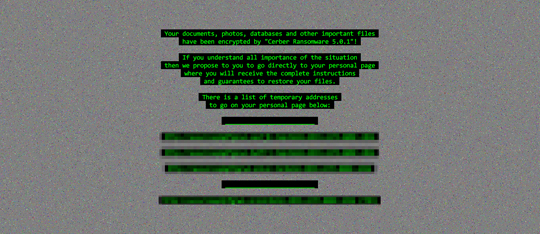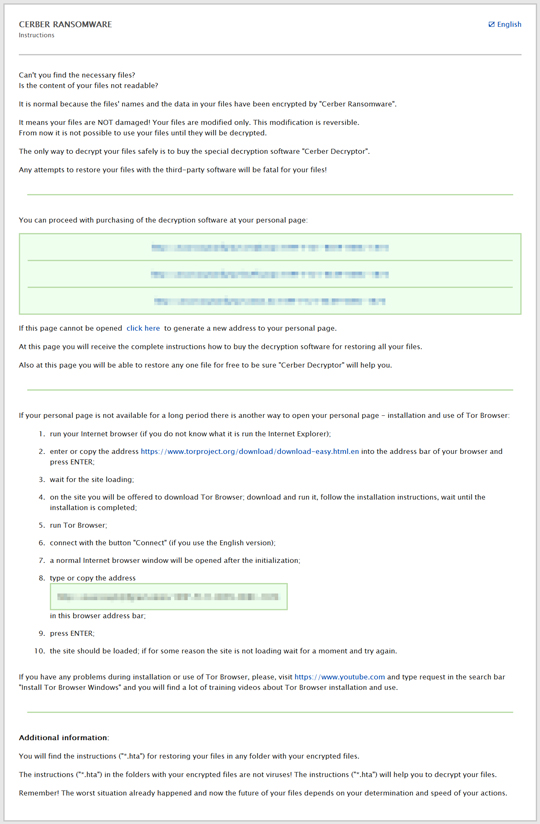RANSOM_CERBER.AUSJB
Ransom:Win32/Cerber (Microsoft); Trojan-Ransom.Win32.Zerber.aiwh (Kaspersky)
Windows


Threat Type: Ransomware
Destructiveness: No
Encrypted: No
In the wild: Yes
OVERVIEW
Downloaded from the Internet
This Ransomware arrives on a system as a file dropped by other malware or as a file downloaded unknowingly by users when visiting malicious sites.
It connects to certain websites to send and receive information. It deletes the initially executed copy of itself.
TECHNICAL DETAILS
278,307 bytes
EXE
No
25 Nov 2016
Connects to URLs/IPs, Encrypts files, Displays message/message boxes
Arrival Details
This Ransomware arrives on a system as a file dropped by other malware or as a file downloaded unknowingly by users when visiting malicious sites.
Installation
This Ransomware drops the following files:
- {folder of encrypted files}\_README_.hta - ransom note
- %Desktop%\_README_.hta
- %User Temp%\tmp{random numbers}.bmp - ransom note wallpaper
- %User Temp%\{random characters}\{random characters}.tmp
- %User Temp%\_README_.hta - ransom note
(Note: %Desktop% is the desktop folder, where it usually is C:\Documents and Settings\{user name}\Desktop in Windows 2000, Windows Server 2003, and Windows XP (32- and 64-bit); C:\Users\{user name}\Desktop in Windows Vista (32- and 64-bit), Windows 7 (32- and 64-bit), Windows 8 (32- and 64-bit), Windows 8.1 (32- and 64-bit), Windows Server 2008, and Windows Server 2012.. %User Temp% is the user's temporary folder, where it usually is C:\Documents and Settings\{user name}\Local Settings\Temp on Windows 2000, Windows Server 2003, and Windows XP (32- and 64-bit); C:\Users\{user name}\AppData\Local\Temp on Windows Vista (32- and 64-bit), Windows 7 (32- and 64-bit), Windows 8 (32- and 64-bit), Windows 8.1 (32- and 64-bit), Windows Server 2008, and Windows Server 2012.)
It creates the following folders:
- %User Temp%\{random characters}
(Note: %User Temp% is the user's temporary folder, where it usually is C:\Documents and Settings\{user name}\Local Settings\Temp on Windows 2000, Windows Server 2003, and Windows XP (32- and 64-bit); C:\Users\{user name}\AppData\Local\Temp on Windows Vista (32- and 64-bit), Windows 7 (32- and 64-bit), Windows 8 (32- and 64-bit), Windows 8.1 (32- and 64-bit), Windows Server 2008, and Windows Server 2012.)
Other System Modifications
This Ransomware adds the following registry entries:
HKEY_CURRENT_USER\Control Panel\Desktop
Wallpaper = %User Temp%\tmp{random numbers}.bmp
Process Termination
This Ransomware terminates the following processes if found running in the affected system's memory:
- agntsvc.exe
- dbeng50.exe
- dbsnmp.exe
- encsvc.exe
- firefoxconfig.exe
- isqlplussvc.exe
- msftesql.exe
- mydesktopqos.exe
- mydesktopservice.exe
- mysqld.exe
- mysqld-nt.exe
- mysqld-opt.exe
- ocautoupds.exe
- ocomm.exe
- ocssd.exe
- oracle.exe
- sqbcoreservice.exe
- sqlagent.exe
- sqlbrowser.exe
- sqlservr.exe
- sqlwriter.exe
- synctime.exe
- tbirdconfig.exe
- xfssvccon.exe
Other Details
This Ransomware connects to the following website to send and receive information:
- {BLOCKED}.{BLOCKED}.11.0/27
- {BLOCKED}.{BLOCKED}.12.0/27
- {BLOCKED}.{BLOCKED}.16.0/22
It encrypts files with the following extensions:
- .1cd
- .3dm
- .3ds
- .3fr
- .3g2
- .3gp
- .3pr
- .7z
- .7zip
- .aac
- .ab4
- .abd
- .acc
- .accdb
- .accde
- .accdr
- .accdt
- .ach
- .acr
- .act
- .adb
- .adp
- .ads
- .agdl
- .ai
- .aiff
- .ait
- .al
- .aoi
- .apj
- .apk
- .arw
- .ascx
- .asf
- .asm
- .asp
- .aspx
- .asset
- .asx
- .atb
- .avi
- .awg
- .back
- .backup
- .backupdb
- .bak
- .bank
- .bay
- .bdb
- .bgt
- .bik
- .bin
- .bkp
- .blend
- .bmp
- .bpw
- .bsa
- .c
- .cash
- .cdb
- .cdf
- .cdr
- .cdr3
- .cdr4
- .cdr5
- .cdr6
- .cdrw
- .cdx
- .ce1
- .ce2
- .cer
- .cfg
- .cfn
- .cgm
- .cib
- .class
- .cls
- .cmt
- .config
- .contact
- .cpi
- .cpp
- .cr2
- .craw
- .crt
- .crw
- .cry
- .cs
- .csh
- .csl
- .css
- .csv
- .d3dbsp
- .dac
- .das
- .dat
- .db
- .db_journal
- .db3
- .dbf
- .dbx
- .dc2
- .dcr
- .dcs
- .ddd
- .ddoc
- .ddrw
- .dds
- .def
- .der
- .des
- .design
- .dgc
- .dgn
- .dit
- .djvu
- .dng
- .doc
- .docm
- .docx
- .dot
- .dotm
- .dotx
- .drf
- .drw
- .dtd
- .dwg
- .dxb
- .dxf
- .dxg
- .edb
- .eml
- .eps
- .erbsql
- .erf
- .exf
- .fdb
- .ffd
- .fff
- .fh
- .fhd
- .fla
- .flac
- .flb
- .flf
- .flv
- .flvv
- .forge
- .fpx
- .fxg
- .gbr
- .gho
- .gif
- .gray
- .grey
- .groups
- .gry
- .h
- .hbk
- .hdd
- .hpp
- .html
- .ibank
- .ibd
- .ibz
- .idx
- .iif
- .iiq
- .incpas
- .indd
- .info
- .info_
- .iwi
- .jar
- .java
- .jnt
- .jpe
- .jpeg
- .jpg
- .js
- .json
- .k2p
- .kc2
- .kdbx
- .kdc
- .key
- .kpdx
- .kwm
- .laccdb
- .lbf
- .lck
- .ldf
- .lit
- .litemod
- .litesql
- .lock
- .ltx
- .lua
- .m
- .m2ts
- .m3u
- .m4a
- .m4p
- .m4v
- .ma
- .mab
- .mapimail
- .max
- .mbx
- .md
- .mdb
- .mdc
- .mdf
- .mef
- .mfw
- .mid
- .mkv
- .mlb
- .mmw
- .mny
- .money
- .moneywell
- .mos
- .mov
- .mp3
- .mp4
- .mpeg
- .mpg
- .mrw
- .msf
- .msg
- .mts
- .myd
- .nd
- .ndd
- .ndf
- .nef
- .nk2
- .nop
- .nrw
- .ns2
- .ns3
- .ns4
- .nsd
- .nsf
- .nsg
- .nsh
- .nvram
- .nwb
- .nx2
- .nxl
- .nyf
- .oab
- .obj
- .odb
- .odc
- .odf
- .odg
- .odm
- .odp
- .ods
- .odt
- .ogg
- .oil
- .omg
- .one
- .orf
- .ost
- .otg
- .oth
- .otp
- .ots
- .ott
- .p12
- .p7b
- .p7c
- .pab
- .pages
- .pas
- .pat
- .pbf
- .pcd
- .pct
- .pdb
- .pdd
- .pef
- .pfx
- .php
- .pif
- .pl
- .plc
- .plus_muhd
- .pm
- .pm!
- .pmi
- .pmj
- .pml
- .pmm
- .pmo
- .pmr
- .pnc
- .pnd
- .png
- .pnx
- .pot
- .potm
- .potx
- .ppam
- .pps
- .ppsm
- .ppsx
- .ppt
- .pptm
- .pptx
- .prf
- .private
- .ps
- .psafe3
- .psd
- .pspimage
- .pst
- .ptx
- .pub
- .pwm
- .py
- .qba
- .qbb
- .qbm
- .qbr
- .qbw
- .qbx
- .qby
- .qcow
- .qcow2
- .qed
- .qtb
- .r3d
- .raf
- .rar
- .rat
- .raw
- .rdb
- .re4
- .rm
- .rtf
- .rvt
- .rw2
- .rwl
- .rwz
- .s3db
- .safe
- .sas7bdat
- .sav
- .save
- .say
- .sd0
- .sda
- .sdb
- .sdf
- .secret
- .sh
- .sldm
- .sldx
- .slm
- .sql
- .sqlite
- .sqlite3
- .sqlitedb
- .sqlite-shm
- .sqlite-wal
- .sr2
- .srb
- .srf
- .srs
- .srt
- .srw
- .st4
- .st5
- .st6
- .st7
- .st8
- .stc
- .std
- .sti
- .stl
- .stm
- .stw
- .stx
- .svg
- .swf
- .sxc
- .sxd
- .sxg
- .sxi
- .sxm
- .sxw
- .tax
- .tbb
- .tbk
- .tbn
- .tex
- .tga
- .thm
- .tif
- .tiff
- .tlg
- .tlx
- .txt
- .upk
- .usr
- .vbox
- .vdi
- .vhd
- .vhdx
- .vmdk
- .vmsd
- .vmx
- .vmxf
- .vob
- .vpd
- .vsd
- .wab
- .wad
- .wallet
- .war
- .wav
- .wb2
- .wma
- .wmf
- .wmv
- .wpd
- .wps
- .x11
- .x3f
- .xis
- .xla
- .xlam
- .xlk
- .xlm
- .xlr
- .xls
- .xlsb
- .xlsm
- .xlsx
- .xlt
- .xltm
- .xltx
- .xlw
- .xml
- .xps
- .xxx
- .ycbcra
- .yuv
- .zip
It renames encrypted files using the following names:
- {10 Random Characters}.{4 Random Characters}
It does the following:
- It terminates itself if found running in any of the following countries:
- Armenia
- Azerbaijan
- Belarus
- Georgia
- Kazakhstan
- Kyrgyzstan
- Moldova
- Russia
- Tajikistan
- Turkmenistan
- Ukraine
- Uzbekistan
- It avoids encrypting files in the following paths:
- {drive letter}:\$recycle.bin
- {drive letter}:\$windows.~bt
- {drive letter}:\boot
- {drive letter}:\documents and settings\all users
- {drive letter}:\documents and settings\default user
- {drive letter}:\documents and settings\localservice
- {drive letter}:\documents and settings\networkservice
- {drive letter}:\program files
- {drive letter}:\program files (x86)
- {drive letter}:\programdata
- {drive letter}:\recovery
- {drive letter}:\recycler
- {drive letter}:\users\all users
- {drive letter}:\windows
- {drive letter}:\windows.old
- \appdata\local
- \appdata\locallow
- \appdata\roaming\adobe\flash player
- \appData\roaming\apple computer\safari
- \appdata\roaming\ati
- \appdata\roaming\intel
- \appdata\roaming\intel corporation
- \appdata\roaming\google
- \appdata\roaming\macromedia\flash player
- \appdata\roaming\mozilla
- \appdata\roaming\nvidia
- \appdata\roaming\opera
- \appdata\roaming\opera software
- \appdata\roaming\microsoft\internet explorer
- \appdata\roaming\microsoft\windows
- \application data\microsoft
- \local settings
- \public\music\sample music
- \public\pictures\sample pictures
- \public\videos\sample videos
- \tor browser
- It avoids encrypting the following files:
- bootsect.bak
- iconcache.db
- ntuser.dat
- thumbs.db
- It speaks the following text using text-to-speech application:
- Attention! Attention! Attention! Your documents, photos, databases and other important files have been encrypted!
- It is configured to target related files under the following folders:
- {drive letter}:\documents and settings\all users\documents\
- \appdata\roaming\microsoft\office\
- \excel\
- \microsoft sql server\
- \onenote\
- \outlook\
- \powerpoint\
- \steam\
- \the bat!\
- \thunderbird\
- It deletes all shadow copies by executing the following in the command prompt:
%System%\wbem\WMIC.exe shadowcopy delete
(Note: %System% is the Windows system folder, where it usually is C:\Windows\System32 on all Windows operating system versions.)
It deletes the initially executed copy of itself
NOTES:
This ransomware changes the wallpaper to the following image:

It displays the ransom note with the following content:

SOLUTION
9.850
12.920.06
25 Nov 2016
12.921.00
26 Nov 2016
Step 1
Before doing any scans, Windows XP, Windows Vista, and Windows 7 users must disable System Restore to allow full scanning of their computers.
Step 2
Note that not all files, folders, and registry keys and entries are installed on your computer during this malware's/spyware's/grayware's execution. This may be due to incomplete installation or other operating system conditions. If you do not find the same files/folders/registry information, please proceed to the next step.
Step 3
Delete this registry value
Important: Editing the Windows Registry incorrectly can lead to irreversible system malfunction. Please do this step only if you know how or you can ask assistance from your system administrator. Else, check this Microsoft article first before modifying your computer's registry.
- In HKEY_CURRENT_USER\Control Panel\Desktop
- Wallpaper = %User Temp%\tmp{random numbers}.bmp
- Wallpaper = %User Temp%\tmp{random numbers}.bmp
Step 4
Search and delete these folders
- %User Temp%\{random characters}
Step 5
Search and delete these files
- {folder of encrypted files}\_README_.hta
- %Desktop%\_README_.hta
- %User Temp%\_README_.hta
- %User Temp%\tmp{random numbers}.bmp
- %User Temp%\{random characters}\{random characters}.tmp
Step 6
Reset your Desktop properties
Step 7
Scan your computer with your Trend Micro product to delete files detected as RANSOM_CERBER.AUSJB. If the detected files have already been cleaned, deleted, or quarantined by your Trend Micro product, no further step is required. You may opt to simply delete the quarantined files. Please check this Knowledge Base page for more information.
Step 8
Restore encrypted files from backup.
Did this description help? Tell us how we did.

